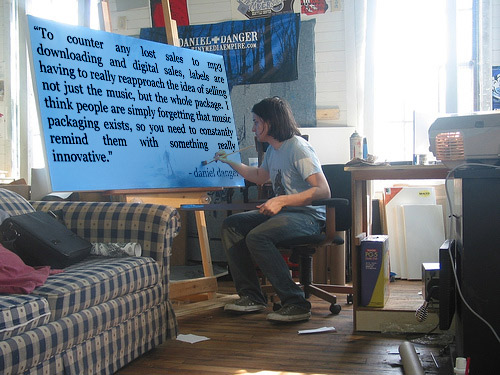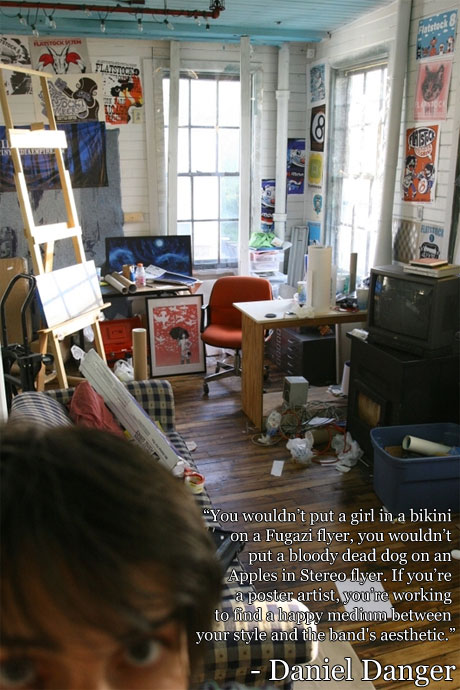
Scene Point Blank: Many of your prints go on eBay for very large sums of money, sometimes double or triple the original price. What are your thoughts on this? Flattering or ridiculous?
Daniel Danger: I really don?t have a problem with it if it?s done in a respectful manner. If you wanna sell the print you bought a year or two ago, then awesome. Art isn?t a good investment, but it's an investment none the less. Some early prints sell for hundreds of dollars, and were mostly sold to poor punk rock kids at the time for $20. I don?t expect them to hold onto that stuff if they got rent to pay or whatever. It?s those fuckers that buy shit and immediately have it up on eBay or wherever for 10 times the price. Or the people who outright lie to me to get prints early, or get two, so they can sell them to make a quick buck. Those people need to shot in the face with a crossbow. But one of the smartest ways I?ve heard it put is that a collection is a means to an end, that people buy things to be able to afford other pieces they want more. So I guess that?s the devils advocate position on it. But still, if I find out someone is a flipper, I wont sell to them. Fuck that.
Scene Point Blank: To go along with the last question, the latest Jake Bannon print now sells on eBay for insane amounts of money, and was only sold for $40. Bannon came out and basically told people to stop being stupid and spend that much money on his prints. On the other hand, do you think it's the artist's responsibility to make more copies, knowing how popular the piece will be?
Daniel Danger: That?s just sort of par for the course when dealing with limited anythings. It?s not really the artists responsibility to cater to everyone who could possibly want a copy at some point, it?s impossible to judge that. Most artists, myself included, are more interested in getting a run done, out, sold, and then using that money to start up the next image and print. I have pretty sizeable editions, 150-200 usually, and my numbers are right at the point where if you want a print, and you show up the first day and make a reasonable attempt to get it, and stay informed on my doings and sales, you?ll get one. If you come by a couple days later, you?ve probably missed out.
It?s the same thing with those Bannon prints, if you paid attention to Bannon and were on the Deathwish mailing list and were a Converge fan or whatever, you knew those prints were coming. I had no problem getting one. That wasn?t a small edition either... on the artist's side of things that, ?I better not miss out this time,? mentality is a big help, to keep the interest of new people.
Scene Point Blank: There was a controversy a while ago when a show promoter made a controversial flyer for a show, and one of the performers took offense to it and refused to play. What do you feel is the artist's responsibility in a situation for this? Compromise their art in order to appeal to the performer, or keep their art and face the consequences of a missing performer?
Daniel Danger: Not performing because of a flyer is a bit silly, because people came to see you play who had nothing to do with the flyer, but it?s 100% the responsibility of the person making the flyer to not only advertise the show, but to make sure the flyer represents the bands playing. That?s the whole point. You wouldn?t put a girl in a bikini on a Fugazi flyer, you wouldn?t put a bloody dead dog on an Apples in Stereo flyer. If you?re a poster artist, you?re working to find a happy medium between your style and the band's aesthetic. If you?re a poster artist, you?re supposed to appeal to the performer, its their show. The key is to just make it distinctly your style with nods to the band and what they?re about, which is really easy if you read some lyrics and pay attention to symbols and things the bands use. It doesn?t take much.
Scene Point Blank: Do you feel that bands are putting enough of an emphasis on their album artwork in punk today? To go along with that, how involved are the bands you work with when it comes to album artwork? Do you get free reign, or does the band tell you what they are looking for?
Daniel Danger: There?s always a good sense of one-up-manship with album artwork and layout, so recently there?s been some really, really amazing layouts and packaging. And that makes me way happy to see. To counter any lost sales to mp3 downloading and digital sales, labels are having to really reapproach the idea of selling not just the music, but the whole package. I think people are simply forgetting that music packaging exists, so you need to constantly remind them with something really innovative. There?s always going to be those kids who are like, ?Well, we?ll just photocopy our covers and sharpie marker the cds,? but what?s the point of even releasing something if you?re going to half-ass it in the end? I don?t think my eyes even seephotocopied stapled cd-r?s on merch tables, it basically tells me you don?t care very much about your release. I know that?s a really awful way to look at it, because it?s supposed to be about the music, but oh well, it?s true. I?m always gonna be that 13 year old kid opening up his Screeching Weasel CD on the ride home so I can read the booklet and see if there?s anything under the tray, even though I can?t even listen to it until I get home.
As for doing layouts, I avoid the route of being, ?Illustrator for hire,? where I draw what you tell me to draw. I?ve had some really lame pre-decided cover concepts thrown at me, and I?ve just passed on the whole layout when they didn?t want to budge. I prefer the route that someone sees my work, thinks my aesthetic would work with their album, and wants something I would do on my own as their cover. Usually I ask bands for the album in advance, lyrics, a basic color direction, and any symbols or concepts they as a band use a lot. For example, with the Hue of Two, everything was hospital themed and we put a hospital cross on everything. That sort of stuff is really helpful. then I sit down and just sort of interpret what I hear into a concept idea for them. usually it?s a single line from a song and just something they said. The last layout I did, all they said was, ?A city, and red,? and off I went. That?s how I like to work. I?m not interested in drawing an anime girl on a skateboard jumping over the twin towers while shooting a plane down. I mean, I am, but I don?t want to put my name on it. Hypocritical exception, the cover I did for Massacre of the Umbilical Cord with the dude riding the polar bear in an ice age future with an uzi and a gasmask. That just had to be done.
Scene Point Blank: What was your take on the recent controversy with Brent Eyestone's album artwork that got rejected? Obliviously in that case it seemed the rejection was a bit extreme, but do you think there are some lines that shouldn't be crossed? *
Daniel Danger: Did you see the limited packaging of that album? Brent needs to be in fucking jail for that one, that shit went way over the line. And yet, I totally own it. It?s on my shelf right over there. But you?re supposed to push lines in art and punk rock, gotta keep things moving and keep that line properly exercised. That artwork I?m sure was rejected by a 50 year old dude in khakis, and I?m pretty sure that was the point of it all.

Scene Point Blank: I always try to end interviews with fun questions, so here is yours: Who would win in this death match: Mid-80's Mike Tyson vs. Bruce Lee in his prime. I personally go with Tyson, just because he is my favorite person ever.
Daniel Danger: I?m gonna have to go with Mike Tyson, because that dude is totally fucking batshit insane. If he ever got Bruce into some kind of hold, he?d kill him, because he?s that far gone from reality. Ever see that clip where he talks about how he won?t be interviewed by a woman unless he fornicates with them first? Yeah, that dominating fucknut mentality is what?s going to put him out on top.
*Author's note: For those that don?t know, Brent Eyestone, who runs Magic Bullet Records, did the artwork for the recent Massacre of the Umbilical Cord and Control split. The artwork featured music icons such as Elvis Presley and Kurt Cobain, encircled by the devices that killed them. When the artwork was sent to get pressed, it was rejected and the plant refused to print it. While another plant pressed the artwork, Brent did his own limited run of the cd to prove his point. Limited to only 20, the cd came packaged in wooden cigar boxes, which came with a syringe, spent bullet casing, as well as death certificates. Pictures can be seen on the Magic Bullet website.
Interview by Cory | Graphics by an intimidated Matt
You can find Daniel Danger's official site here.







